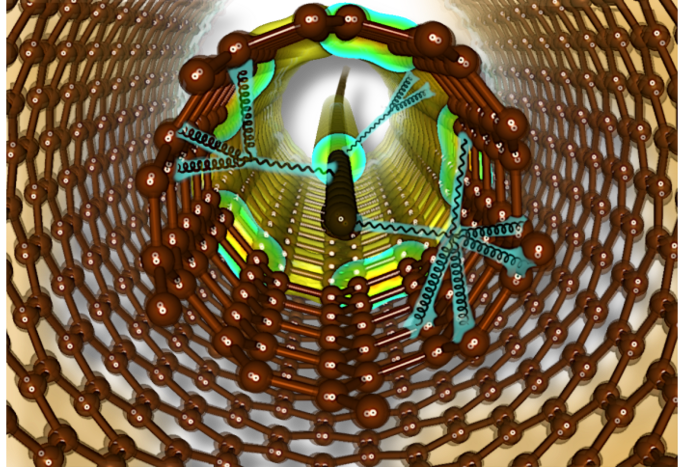Reviewed by Lexie CornerMay 28 2025
Researchers from China, Japan, France, Italy, and Austria, led by the University of Vienna, have fully unraveled a long-standing materials science mystery using machine learning, advanced theoretical models, and Raman spectroscopy.
Published in Nature Communications, the study demonstrates that carbyne (a one-dimensional chain of carbon atoms) exhibits unique vibrational states that make it highly sensitive to external influences, suggesting broad potential for sensor applications.
 Schematic representation of carbyne stabilized inside small-diameter double-walled carbon nanotubes. Image Credit: Emil Parth, Faculty of Physics, University of Vienna
Schematic representation of carbyne stabilized inside small-diameter double-walled carbon nanotubes. Image Credit: Emil Parth, Faculty of Physics, University of Vienna
Understanding the quantum mechanical interactions between individual atoms is essential for designing next-generation materials. For years, scientists have been puzzled by unusual vibrational states observed between carbon chains (carbyne) and carbon nanotubes - states that defied existing theoretical explanations.
All macroscopic material properties - such as electrical conductivity, magnetism, optical behavior, and elasticity - are governed by quantum-level interactions. Researchers use Raman spectroscopy, a method that probes the interaction between light and matter, to identify the vibrational eigenstates of atomic nuclei in materials.
In a major breakthrough nine years ago, Thomas Pichler's group at the University of Vienna succeeded in stabilizing carbyne inside carbon nanotubes for the first time. Carbyne, which exists only in these confined conditions, has tunable electronic properties relevant to semiconductor applications and may possess the highest tensile strength of any known material.
However, the experiment revealed an unexpected system state that did not align with existing theoretical models and was initially misinterpreted.
In the new study, the researchers revisited this anomaly in greater detail. Leveraging recent advancements in machine learning, they developed a new theoretical framework that explains the counterintuitive interactions between the carbon chains and the nanotube walls. This model sheds light on previously unaccounted-for coupling effects and opens up new directions for nanoscale material design and sensor development.
Although the chain and the nanotube are electronically isolated and therefore do not exchange electrons, they are subject to an unexpectedly strong coupling between the vibrations of the two nanostructures.
Emil Parth, Study Lead Author, University of Vienna
In other words, the carbyne and the surrounding nanotube can interact electronically, despite appearing electronically isolated in classical terms. This form of quantum mechanical vibrational coupling is typically weak, but in this case, it is exceptionally strong due to the chain’s unique electronic properties and inherent structural instability.
What makes carbyne particularly interesting is its pronounced sensitivity to external influences, which drives strong interaction with the nanotube environment. The study also reveals that this interaction is bidirectional: the presence of carbyne not only responds to but also modifies the nanotube’s properties, though in a way that challenges earlier assumptions.
The sensitivity of carbyne to external influences is crucial for its potential application in future materials and devices as a contactless optical sensor on the nanoscale, for example, as a local temperature sensor for heat transport measurements.
Thomas Pichler, Head of Research Group, University of Vienna
The EU funded the study through the ERC-SYN grant MORE-TEM.
Journal Reference:
Parth, E., et al. (2025) Anharmonic effects control interaction of carbyne confined in carbon nanotubes shaping their vibrational properties. Nature Communications. doi.org/10.1038/s41467-025-59863-3.